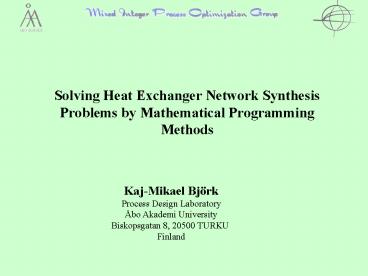Solving Heat Exchanger Network Synthesis Problems by Mathematical Programming Methods - PowerPoint PPT Presentation
1 / 15
Title:
Solving Heat Exchanger Network Synthesis Problems by Mathematical Programming Methods
Description:
Process Design Laboratory. bo Akademi University. Biskopsgatan 8, ... A new convexification technique used. a set of convex approximate subproblems to be solved ... – PowerPoint PPT presentation
Number of Views:174
Avg rating:3.0/5.0
Title: Solving Heat Exchanger Network Synthesis Problems by Mathematical Programming Methods
1
Solving Heat Exchanger Network Synthesis Problems
by Mathematical Programming Methods
Kaj-Mikael Björk Process Design Laboratory Åbo
Akademi University Biskopsgatan 8, 20500 TURKU
Finland
2
Background
- Some models with simultaneous optimization of
investment and running costs - Models with a continuous tempertaure
representation - Synheat model by Yee and Grossmann
- Models with a discrete temperature representation
- w1 and w2 in Westerlund et al.
3
Sequential Optimisation
- Mathematical programming used
- Moderate computational effort
- Trade-off not handled simultaneously
STEPWISE PROCEDURE
min Area s.t. min no. of units
s.t. min util. costs
4
Simultaneous Synheat ModelStagewise
superstructure model
- Trade-offs handled simultaneously
- The best solution can be found
- Assumes
- counter-current HEX
- constant Fcps
- constant Us
The Superstructure an Example
C1
H1
C2
5
Synheat Model Limitations
- More computational effort needed
- Non-convex obj. fcn.
- Global optimum not guaranteed
- Assuming isothermal mixing
Isothermal Mixing
T1
T3
T2
T1 T2 T3
6
Improvements of Synheat
- Modifications to ensure convergence to the global
optimum for both with and without the isothermal
mixing assumption - earlier work by Zamora B B approach for
Synheat with no stream splits - A new convexification technique used
- a set of convex approximate subproblems to be
solved - convexifying posynomials (xr1yr2zr3 ... )
7
Convexification technique an Example
- Convexifying a bilinearity xy
- Exponential transformation
- Need to include the relationship between the
variables due to other constraints
X ln(x),Y ln(y), approximated by a stepwise
linear function
xy is replaced by Exp(XY) X ln(x) Y ln(y)
8
Results Continuous T
- Assuming isothermal mixing
- quite time consuming
- solved 2 hot 4 cold
- Without isothermal mixing assumption
- time consuming due to more nonlinear constraints
- solved 2 hot 2 cold
9
Future work Continuous T
- Speeding up convergence
- modified global optimization approach ??
- using more suitable MINLP-solver (Dicopt?)
- Testing non-global optimization approaches and
comparing them - Testing stocastic optimization methods
10
Discrete Temp. representation
- Advantages
- Fcp calculations done a priori
- Area calculations done a priori
- Power law area costs only nonlinear functions
remaining - Small number of binary variables
- Disadvantages
- Increased size of problem
- No good superstructure
- Every thermo-dynamically possible structure
- Only stream splitting
11
HRS-systems in paper machines
- Dry air into the dryer, process-water and the
machine hall need to be heated - Humid air from the dryer can be used as a heat
source - Normally all these demands and supplies are
combined in the heat exchanger network
12
Pressurized HRS-tower by Valmet
- Combined air-air and air-water heat exchanger
- Typical series decoupling
New model needed
13
Hybrid model
- Combined discrete model (w2) with Synheat
superstructure - Not straight-forward since Synheat superstructure
associated with continuous temperatures - Need of addressing more binary variables
- Only nonlinear function still power law area cost
functions
Large-sized and time consuming model, but gives
most promising solutions
14
Global optimization procedure
- Replacing power law area costs with a stepwise
linear fcn.
15
Conclusion Discrete T
- Hybrid model needed due to the non-linear area
and heat content calculations for HRS-systems in
paper-machines - Solved to the global optimum with a
special-purpose global optimization procedure - The Hybrid model is time consuming but finds the
most promising solutions due to a good
superstructure





























